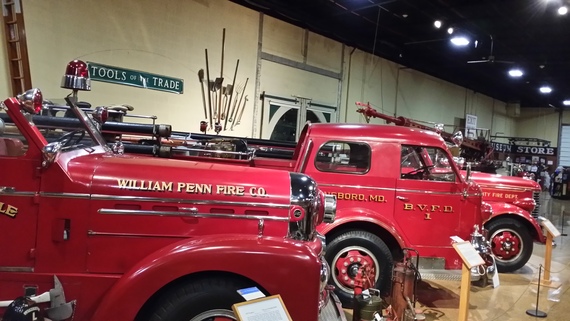Much More Than a Museum
By Kelly Medinger
10-30-2014
Fire Museum of Maryland uses arts and humanities grant to put a spotlight on technology, democracy, and heroism
 Standing in front of the new Fire Alarm Office at the Fire Museum of Maryland, a group of school children chant, “911, fire! 911, fire!” They clearly know who to call and what to say when they see a fire.
Standing in front of the new Fire Alarm Office at the Fire Museum of Maryland, a group of school children chant, “911, fire! 911, fire!” They clearly know who to call and what to say when they see a fire.
A Story about Saving Lives
Founded in 1971, the Fire Museum appears to be one of Baltimore’s best kept secrets. It is one of the largest fire museums in the country and holds some of the oldest pieces of fire equipment. “Together our 41 pieces tell the story of American urban firefighting,” shares Steve Heaver, Director and Curator of the Museum. “It is the story of how people help people. How they save their lives.”
Each year more than 12,000 people come to the Fire Museum to tour its collection, conduct research in its archives, participate in a special event, or even celebrate a birthday party. The Museum relies on a team of approximately 25 people, half of them volunteers, to keep things running smoothly.
Even with a small budget and a small staff, Heaver has a big vision: double the number of visitors to the Fire Museum to 25,000. He estimates that they can achieve this goal without increasing staffing or overhead, simply by taking advantage of economies of scale. “It’s not beyond the realm of possibility,” he says with a smile.
A Path of Technological Innovation
Walking through the museum is like taking a step into the history of fighting fire. Visitors follow a path of technological innovation from the earliest years of hand drawn firefighting (1654 – Civil War), through the horse drawn period (1852 – World War I), and then finally the motorized era (1906 – present). Each piece of the collection is cared for and restored by the staff and speaks to the ingenuity of humankind. Many pieces in the collection are even from our own backyard – Baltimore City, Boonsboro, Ellicott City, and the Violetville neighborhood, to name a few.
The Knott Foundation recently helped the Fire Museum renovate lighting for its exhibit space. With this grant and gifts from multiple other donors, the Museum replaced all of its 1971 fluorescent lamp fixtures and installed new LED lights as well as some track spot lights. “The new lights not only save energy and keep the artifacts from fading, they are much more visually pleasing,” Heaver comments.
By telling the story of American urban firefighting, the Fire Museum manages to be so much more than a museum: It becomes a lesson in democracy and making decisions. It serves as an example of technology improving peoples’ lives. And it ultimately stands as a witness to heroism.
